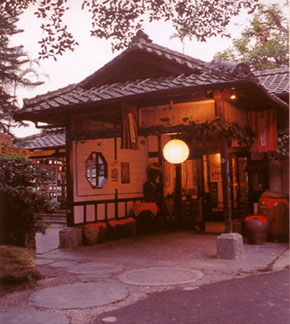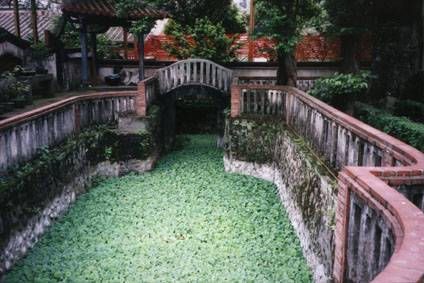A Survey of the Art Scene in Taiwan
(Republic of China)
Continued from Page 1
by Roger McClanahan

Mural
A Survey of the Art Scene in Taiwan(Republic of China)Continued from Page 1 by Roger McClanahan |
 Mural |
TaichungIn Taichung, a charming city which was once the capital of Taiwan when it was still known as Formosa, I visited Want Space, an alternative gallery, café, and artists hangout. The city itself has a hip, casual, lowscale quality that I loved. The artists I met at this space varied enormously in age and accomplishments. What I must comment on which was true throughout Taiwan was that individual artists were extremely kind to each other. They were very anxious to show you another artist's catalogues, to make room for everyone to meet the visitors and have an opportunity to express themselves. Young artists who were often more fluent in English would translate for the other artists. In the New York art world which sometimes seems like dog eat dog, it was very refreshing to find this attitude of cooperation and consideration. While I met over fifteen artists at this gathering, one artist Ching Hung Chen had studied in the United States in Saint Louis and had won several awards for his drawings. I expect he is one of the artists we will be hearing from in the future. |
 Mural |
In the north of Taichung we visited the studio of Hunag Chin-ho. Located next to the train tracks in a large airplane hanger of a place, he has huge paintings, which often echoed the death-oriented theme of some Buddhist beliefs. He created an altar at one side of his studio. He had an enormous canvas covered with an interpretation of fighting gods with mildly pornographic or at least sexually explicit overtones.
|
|
He also showed us some amazing funeral drawings, which are made just before someone dies. He bought them in flea markets and from a collector and they were eirie for sure. To give you a feeling for the slightly surreal quality of this loft visit, there was a very pleasant man named David who was an investment banker and kept calling on his cell phone during our visit. Strange! These trips are not all a piece of cake. In order to make it to our next appointment in Tainan, we grabbed a snack of fried rice and spring water and hit the road. I have said nothing about the food in Taiwan. Let me just say that it you will find the best seafood and vegetarian treats you could wish for. In the big hotels there are groaning boards full of western food, Japanese food, Chinese food and lots of Ice Crème! But in so many odd spots there are small restaurants with simply wonderful food. A brief stop can turn into a spontaneous banquet. Back to art although sometimes a wonderful meal approaches an artistic experience! In Taichung we stopped at another gallery/alternative space. This place was so newly established you could still smell the paint on the walls. It was a coop gallery put together by students from the local Art College. Dr. Ava Hsueh who has a degree from NYU is the moving force in this place along with another professor. The artists, most of whom were recent graduates, showed slides of their work and there was an installation up by Lin Chien-Jung featuring metallic robots that moved across the ceiling. It was almost 11 P.M. We had been on the road for hours. At this point I have to comment that Taiwan was in the middle of a holiday but traffic was horrendous. It all reminded me of the Long Island Expressway or the approach to the Holland Tunnel on a Sunday night. |
 Robots |
Upon my return to Taipei I was able to visit two more spectacular alternative spaces. The Bamboo Curtain Studio which is located in the northeast of Taipei adjacent to the new rapid transit line. The place is a former chicken processing plant and is run very informally by Margaret Chen, an artist from Hong Kong whose husband owns the property. She provides working space to a number of emerging artists as well as offering them technical advice and mother love if you will. |
|
The last alternative space we visited was the Whasang Art District in downtown Taipei. Created on a very temporary basis in a former Japanese beer factory, this place has the feel of PS1. There are rehearsal spaces, artists studios. Most of the place has not been renovated and one can see water damage and holes in floors here and there. It reminded me of the Piers along the Hudson River before they were torn down. The Secretary General of this project is Yun-chin Huang and I would call this a work in progress. Artists were assembling as I had to leave and they also organized a meeting of art critics for Kim Levin who writes for the Village Voice and is the president of the International Art Critics Association. |
 Red Curtain |
Keeping up a daunting pace, I rushed off to lunch with Shiuan-Chyn Yang whom I knew when he was posted to the Taipei Gallery and Cultural Center in Manhattan's Rockefeller Center. He is now the director of an office planning a very exciting Taiwan International Artist Village in the middle of the country at a place called Sun-Moon Lake. This development which has aspects of Storm King combined with artist colonies like Yaddo and the MacDougal Community will have a major impact in the future cultural scene in this country. In fact, the Taiwanese Ministry for Cultural Affairs through its collaboration with artists spaces and cultural foundations around the world will be a new player on the international art scene which must be respected. |
 Chiang Kai-Shek Memorial Hall |
After lunch he and one of his colleagues took me across the street from his office to visit the spectacular Chiang Kai Shek memorial. This is a spectacular place on a par with the Lincoln memorial. Adjacent to this huge building, where one can watch the changing of the guards every hour with their metallic helmets and rifles, is a national theater building. In front of this building performance artists and circus performers carry on constant displays for the amusement of the local audience. This is also one of the prime sites for political demonstrations and protests. The day I was there it simply reminded me of the front steps of the Metropolitan or the Pompideau Museum in Paris, fun and games- all for free. |
|
The next day was Sunday and I decided to join the locals for a visit to the Jade Market and the flower market. These are both located underneath a downtown freeway. The jade market is a sort of flea market with many people selling small items, mostly jade or coins or collectibles of some sort. It is a great place to obtain gifts to take back but also to get an overview of what local people like. The flower market is spectacular because of the variety of tropical orchids and other plants available for sale at such reasonable prices. Of course one can't really take plants home so I just looked and took lots of photos. Late that afternoon I stopped by the Chang Foundation. They were featuring a display of the Qin, an ancient instrument which resembles a zither. It is featured in most of the paintings of the Chinese scholar and was considered essential to the scholar's way of life. The chief curator of the Chang Foundation is James Spencer, a delightful Englishman who used to be the Christie's representative in Hong Kong. He is an expert in Chinese porcelain and also speaks fluent Mandarin. I was totally amazed by his knowledge. The Foundation sponsors a number of overseas exhibits and currently their collection of snuff bottles can be seen in New York City at the Taipei Gallery. On my last day I visited the Shung Ye Museum of Formosan Aborigines which was created by the N.W. Lin Foundation for Culture and Education. This museum is located across the street from the National Palace Museum and displays a wonderful selection of artifacts relating to the aboriginal populations of Taiwan. There are only about 300,000 aborigines surviving, mostly in out of the way places. The photographs, artwork and videos available here represent a wonderful opportunity to experience these fascinating cultures. |
 Taiwan Folk Art Museum |
After lunch in one of the terrific little restaurants which abound in the mountains north of the City, we went to see the Museum of Taiwanese Folk Art. Constructed in what was once a Japanese officer's club, they have a wonderful collection of folk art including some aborigine's materials, costumes, and household implements. This museum is privately operated and shouldn't be missed. |
 Scholar's Garden in the town of Peitou, Taiwan |
|
I finished the day with a visit to a spectacular Buddhist temple in Peitou. On the way back we visited a spectacle scholars garden which is under reconstruction. There is always some thing wonderful about wandering through a spectacular place in semi ruins- loosing your way, coming out the rear door, seeing workers carrying on the reconstruction everywhere. A gentle rain started to fall. This garden and house had been here for three hundred and fifty years. It was the perfect end to two weeks in a country which offers the latest in contemporary and installation art, wonderful alternative spaces, artists who are on the very cutting edge but at the same time an opportunity to see the very best in classical Chinese art and culture. |
| |
Art Review Listings - Artists - Magazine
Click on ORDER FORM for Inquiries - PAYMENT OPTIONS for Art Purchase.
All artwork is copyright of the respective owner or artist. All other material © 2015 New York Art World ®. All Rights Reserved.
NewYorkArtWorld ® - Back to Top - Next